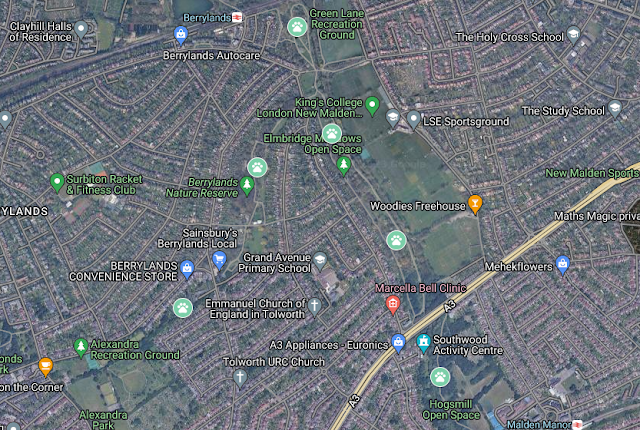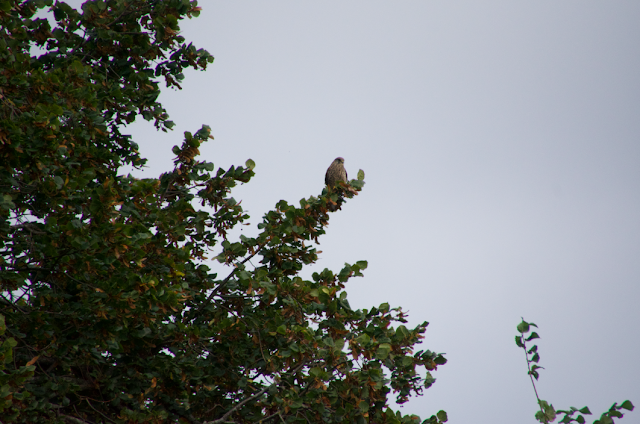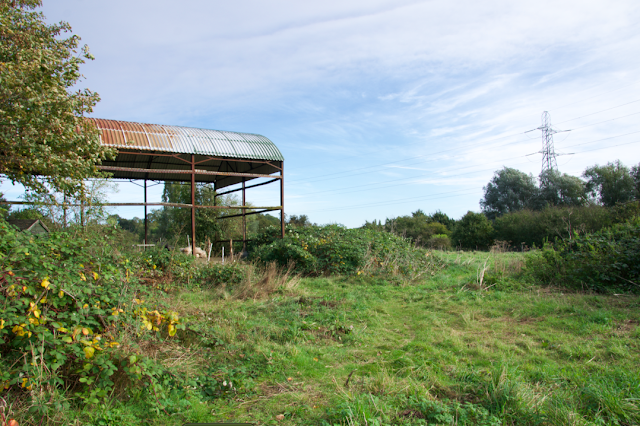22nd October 2021
I arrived at Surbiton station on a cloudy, but mild October morning. My last visit to the borough of Kingston-upon-Thames - in which Surbiton is situated - was more than ten years earlier, to Chessington World of Adventures. Today, however, I was keen to see the Hogsmill Valley, a collection of nature reserves which I had first stumbled upon when making my interactive map Nature Reserves of London.
Soon after I had exited the ticket hall, a car pulled up a few metres away from the station entrance. Driving it was a familiar face: Elliot Newton, a local conservationist and biodiversity officer for Kingston Council. We had met several times over the past three years at numerous different nature conferences, and I had been fascinated by his work to rewild the borough and promote its wildlife. Armed with binoculars, we set off from the station and our whistle-stop tour of Kingston's nature reserves had begun.
We drove through the quaint streets of Surbiton, on the way to our first stop beside the Thames. These streets are steeped in history; seven Anglo-Saxon kings had been crowned just a few miles away. After all, we were in the Royal Borough of Kingston. Road after road of Edwardian houses greeted us, aged yet still grand. We soon reached an embankment by the River, guarded by old rusty railings. Stepping out of the car, Elliot and I carefully examined the area which the embankment overlooked. I was baffled by the sight of concrete basins, each one unkempt and half-filled with mud-coloured, stagnant water. Elliot explained that this was Seething Wells Filter Beds, the site of a former Victorian water pumping station. Like many derelict sites across the capital, nature had reclaimed it. Daubenton's bats feed over the filter beds in the evenings, and the site provides a vital habitat for local wildfowl and the occasional wader. It was relatively quiet when we visited, save for the eerie shriek of a Heron and the odd appearance from a shy Moorhen.
Due to its importance to wildlife in the local area, Seething Wells is a Site of Importance of Nature Conservation (SINC). Twenty percent of the capital's land area consists of SINCs, a designation which recognises the ecological importance of wildlife sites in local authority decisions related to planning and land management. However, despite Seething Wells' SINC status, it saddens me that like so many other wildlife sites across London, it has been threatened by development proposals in the recent past. I sincerely hope that the future of Seething Wells can be safeguarded, so its unique wildlife can flourish.
Driving away from the Seething Wells and the Thames and into the main Hogsmill Valley, we headed towards the very edge of the borough of Kingston.
It is time for a slight deviation into local government history. The borough is very long and narrow, a 'panhandle' which protrudes from the rest of Greater London. When new plans to expand London's administrative boundaries were being discussed in the early 1960s, it was originally proposed that there would be 52 London boroughs, including Kingston and Epsom which were administratively part of Surrey. The residents of these suburbs, particularly in Epsom, refused to join the expanding capital, pressuring the Government to remove them from the final plan, leaving Kingston sticking out into the surrounding administrative districts of Surrey today.
Our next destination was in the middle of this curious 'panhandle', in Tolworth.
The Royal Borough of Kingston, the long 'panhandle' of Greater London
The fields were boggy and saturated by the rainfall from the past week, with Yellow Meadow Anthills spread out among the overgrown grass. With much difficulty, we trudged through the fields to a large cattle shed. Patches of scrubland bordered the shed, with tangled vegetation reaching out towards the poles supporting its arched corrugated iron roof. Just below one corner of the roof sat a Kestrel nestbox, though none had nested yet. In fact, Kestrels were not the only animal absent from the cowshed: so were the cows! Elliot hoped that cattle would arrive in the next few months, with their grazing improving biodiversity on the fields. Their hooves would turn the soil, spreading nutrients, and they would eat more numerous plant species to allow other plants to grow, increasing plant diversity. The idea of cows grazing in Tolworth had triggered a wave of excitement and enthusiasm among local residents, and over a hundred of them had signed up to visit the site and monitor the cattle's progress for most of the year. Cattle were connecting communities with urban nature; something I found truly remarkable.
The fields and cowshed near the A240, Tolworth
Once again, we walked with great effort through the boggy fields, from the cattle shed to a small bird hide at the opposite end of the reserve not too far away. On closer inspection, the hide's entrance had an exquisitely-carved wooden door knocker of a Kingfisher: a nod to the wildlife of the small reedbed which the hide sat next to, fed by the River Hogsmill itself. Gently opening the wooden door, we stepped inside into an interior rather unconventional for a hide. Hay comprised the inner walls and seating, giving a homely, warm and cosy feel. Wooden lids, with delicate handles carved in the shapes of different leaves, could be lifted from between the hay walls to reveal small circular windows looking out onto the reedbed. We fantasised about what birds could potentially be heard during summer. Perhaps an elusive Cetti's Warbler belting from a bulrush its piercing song, or maybe a Water Rail rustling in the reeds. But in October, the birds heralded the coming of autumn. The Moorhen, with its bubbly purr; the Song Thrush, its energetic whistles louder than the distant traffic; and the humble Blue Tit, with its sweet 'chu-chu-chu' trill.
I suppose the hide was like the manor house which once stood in its place. Not to watch over peasants from or defend from enemies, but from which one could enjoy the countryside in seclusion, tucked away from the hubbub of everyday life. One could feel that this was their little slice of paradise in the edgelands of South West London, surrounded by an array of pleasant bird calls and songs. And soon, the mooing of cows.
The interior of the hide
Leaving the fields and crossing the busy road, we reached a wooden bridge over a tangled riverbank: the Hogsmill. Concealed by masses of bright green overgrowth, the rare chalk stream let its presence be known with a timid babble.
The bridge led into Tolworth Court Farm Fields, a protected Local Nature Reserve open to the public. The first field was scattered with tufts of grass and nothing much else. Distant poplars towered above the field like sentries, standing guard at its boundary while looming over us.
Other than the faint bubbly whirring of a Skylark, and brief sight of a Long-tailed Tit, this time of year was a quiet one for the birds of this reserve. Despite the lack of avian visitors, Elliot had remembered discovering something astonishing on his last visit, as we walked towards the vegetated field margins. He carefully examined each and every plant and exclaimed with delight when he had found it under masses of drenched branches: a single butterfly egg. A Brown Hairstreak butterfly egg, to be precise. This species is quite uncommon in London; even so, I had been lucky enough to catch a glimpse of one at Ruislip Gardens two years before, very close to my Eastcote home. The egg was a small white dot, about half a millimetre in diameter. However, zooming in on the egg using the macro setting on my camera revealed its wonderful detail. It resembled a sea creature of some kind, with symmetrical indentations dotted on its surface. A glimmer of life in this otherwise sombre autumnal meadow.
The Brown Hairstreak egg (the white dot in the centre of the twig). I did not manage to take any close-up photos of it!
We headed through a series of fields, all of which were very similar in appearance. Each had acres of tufts of grass, but were surrounded by a magnificent assortment of veteran trees, bushes and hedgerows, their wet foliage draped around them like verdant green robes. Weaving through sodden grass and climbing over a small hill, we chatted about our recent experiences in nature, what birds we had seen in our gardens, the local wildlife campaigns we had been involved in, and the increasing excitement around possible species reintroduction schemes in London. Elliot intended that the following year, he and other local conservationists from a charity he had helped set up, Citizen Zoo, would release Water Voles back into the Hogsmill. Many stretches of the river are too overgrown and in need of management, and Elliot believed Water Voles could rescue the Hogsmill's environment from biodiversity decline.
Much like the introduction of cows on the other side of the motorway, the thought of bringing back these iconic mammals to a rare, urban, chalk stream riverbank ecosystem had elated many residents. The voles' role in bringing back biodiversity to this ecosystem did not sound too dissimilar to that of the cows in the fields; their networks of burrows in the riverbanks would move nutrients around in the soil to increase plant growth, and their feeding on thick grass stems would control the growth of certain plant species and encourage the growth of others. The voles would provide the river with a much-needed cure, by engineering a small part of Kingston's vast urban jungle.

One of the Tolworth Court Farm fields with hedgerows
Elliot and I made our way along a short section of the A240 back to the car after walking out of the reserve. We drove towards our final destination in the leafy streets of Tolworth and Berrylands, not before meandering along Tolworth's criss-crossing main roads. Elliot mentioned that during the pandemic, murals of the borough's wildlife had been painted in the underpasses below by a local group, the Community Brain. The underpasses are situated in an area where residents have a lack of access to green space, so these murals would have allowed them to become familiar with their local wildlife in a way, even if it did not involve witnessing a Roe Deer prancing through long grass or hearing the 'kee, kee' of a Kestrel above.
The streets of Berrylands were much quieter and mostly residential. A disproportionate number of green spaces in this sleepy suburb and its neighbouring areas are designated as Local Nature Reserves (LNRs), sites which are protected by law for their local ecological value. In fact it is this large number of LNRs that drew my attention to Kingston's natural environment in the first place, forming somewhat of a chevron shape when viewed from above.

Local Nature Reserves in Berrylands and the surrounding areas (from left to right): Edith Gardens, Raeburn Open Space (Berrylands Nature Reserve), Rose Walk, Elmbridge Open Space, Hogsmill River Park and Southwood Open Space
Between Rose Walk and Elmbridge Open Space was the peculiar sight of only two parking spaces crammed between a roundabout, a field and a cycle path. Given that there were at least twenty people ahead of us in the latter open space, it was a miracle that one of these parking spaces was free. Elliot and I left the car and walked along a footpath to the bridge. Here the Hogsmill, albeit murkier and appearing to flow more slowly than in Tolworth, came into full view. It was very exciting to think that from spring the next year there would be Water Voles here, let alone the existing Kingfishers, Emperor Dragonflies, Stag Beetles and Hedgehogs already along this stretch of the chalk stream. It is these five species that Elliot calls the 'Big Five' of Kingston, which he uses to illustrate the fantastic wildlife of the borough when educating local schoolchildren about nature.
Trees and overhanging vegetation prevented much access to the Hogsmill by the riverbank opposite the bridge, but showed off their resplendent autumnal hues of gold, russet and brown. Their leaves tumbled down and cloaked the riverbank, squelching beneath our feet as we sat down to admire the river. Dappled sunlight peeked between the thin branches, casting warm pools of light around us, while a Robin sang a few metres above, both of which comforted me amidst a rather cold wind. The not too distant sound of a train whistled through the air, to me a gentle reminder of this unique valley's urban location.
What Elliot, Citizen Zoo and other conservationists in Kingston are achieving is extraordinary. By connecting the borough's residents with their local wildlife through an ambitious nature restoration and rewilding programme, it makes me more hopeful that more areas of London will follow in their stride to enhance our capital's biodiversity. Of course, the Hogsmill Valley like many other ecosystems in the capital faces its challenges and issues, but the resolve and dedication of the locals is inspiring - a shining beacon of hope for this rare chalk stream and its Big Five.

A Kestrel perched above the fields in Tolworth
Note: as this blog post was written based on a visit from two years ago, some changes have taken place. Shortly after my visit the cattle arrived in Tolworth, and in August 2022 Water Voles were reintroduced back into the Hogsmill!




No comments:
Post a Comment